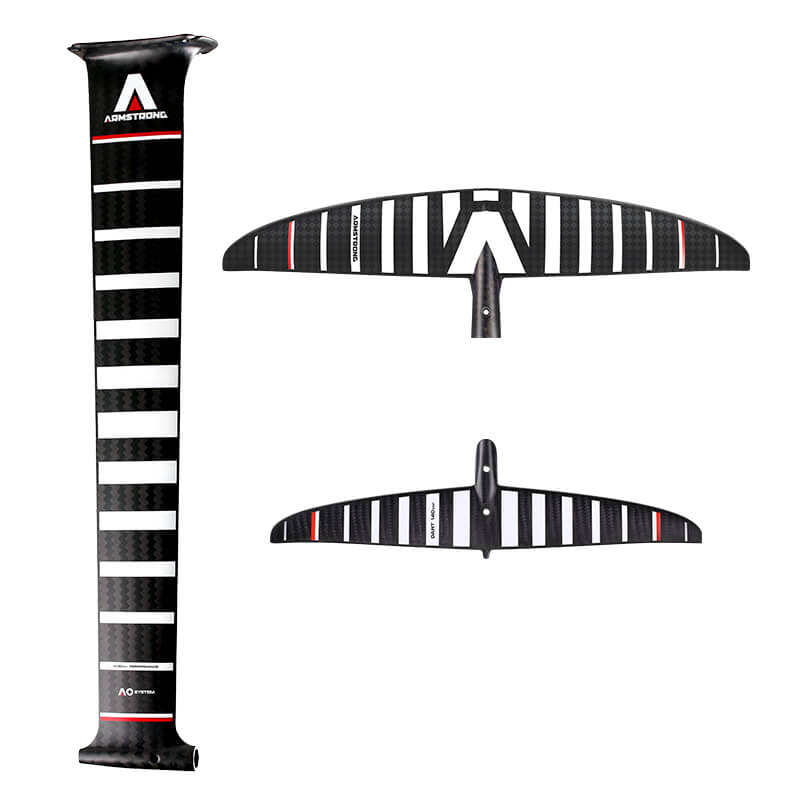When you purchase gear through links on our site, we may earn a small commission. Here’s why you can trust our tests and our affiliate partner.

Armstrong is now a brand synonymous with high-end hydrofoils, and their raging success in the surf and wing foil markets crosses over perfectly into kite foil, particularly in the smaller sizes of their various foil ranges. The MA range has gone down well, particularly for wind and wave driven sports where its agility is up there with the top brass. We were super eager to see how the smallest size in the range would translate into kite foil mode. On test we had the MA 625, P1035 mast, Dart 140 and Speed 180 stabilizers.
From the off this is a considered and complete package, everything has bespoke covers and there’s a generous number of spare bolts to be found taped into each component. It’s built around the well-established A+ System which is utilized across the whole range, with a hexagonal fuselage slotting into the mast to locate tightly and remove any movement, eliminating any harsh drag points. The fuse is fixed in with various M6 torx barrel bolts, with two holding the front wing in. All fixings are titanium and corrosion free so it’s not even necessary to lubricate anything, so whilst there’s quite a few fixings, the system is overall very fuss free.
We tested mainly on the 60cm fuse, which allowed for some drag free velocity and high G force cornering; particularly with all the mast length to utilize, you could really throw your weight around and ride aggressively, and get some hard angles on the mast and it would grip through the bends in a delightfully consistent manner, accelerating out with a snap. If you do manage to breach the tip on the MA625, even at this size, it still has the MA series party trick of recovering extremely predictably, and reengaging with the water cleanly; the same applies when coming in hot from a jump – it seems to bounce back out like a skipping stone. For a relatively small front wing, it didn’t feel too twitchy, and got going impressively early, even for a 90kg test pilot. Perhaps pairing it with the MA1000 for super light wind would be a good shout for the ultra-lightwind scenarios, but it’s no slouch. Also worth mentioning is how good this foil feels through white water. It deals with disturbance and current with plenty of composure.
The P1035 mast is extremely stiff considering its length and with this tiny front wing provides excellent feedback from the foil to your feet. We paired with the WKT 122cm also from Armstrong and with that thin deck pad and ultra stiff board, you know precisely what’s going on underwater at all times. It would be an absolute crime to put it on anything too floppy and lose that. The mast has four countersunk M7 bolts which slide into an open toe arrangement on each corner of the base, which use the same T30 Torx tool.
We tested two stabilizers with this setup, the first being the Speed 180. This was the more forgiving of the two and provided plenty of grip at high speed and was virtually silent. Its efficiency allowed for some extended and effortless gliding when coming off kite power, particularly noticeable when motoring downwind. The Dart 140 is quite a different beast, loosening up the pitch and yaw control and requiring a little more management from the rider; it’s going to suit powered conditions and those who want to really push the top end of the system. For a more forgiving and supportive feel around the corners, to perhaps tame the beast a little, we also slipped on the Surf 205 stabilizer from our wingfoil setup. This slowed things down a little, and made cornering a little more sure footed.
Shimming wise, we didn’t feel the need to run anything over the blue 0.5 degree shim. For a fast propelled sport like kiting we felt there wasn’t so much need to shim as you would for surfing or even wingfoiling, the combo seemed to work very effectively straight out of the box.
As a package this combination of striped Armstrong goodies makes for a flawlessly executed and shamelessly high-end kite foil setup, with definite potential to cross over into towing in bigger waves. This setup could give some race-focused foils a run for their money in a straight line; what it does even better is let you corner extremely hard, load up plenty of speed and line tension for jumps, and absolutely truck upwind if required. If you’re an intermediate or above kite foiler, it’s one of the most entertaining performance freeride foil setups we’ve tested.
